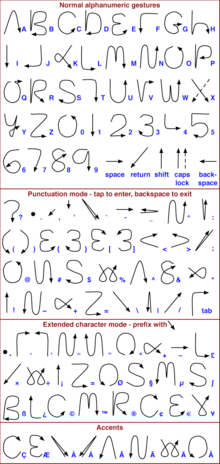Graffiti (Palm OS)

Graffiti is an essentially single-stroke shorthand handwriting recognition system used in PDAs based on the Palm OS. Graffiti was originally written by Palm, Inc. as the recognition system for GEOS-based devices such as HP's OmniGo 100 and 120 or the Magic Cap-line and was available as an alternate recognition system for the Apple Newton MessagePad, when NewtonOS 1.0 could not recognize handwriting very well. Graffiti also runs on the Windows Mobile platform, where it is called "Block Recognizer", and on the Symbian UIQ platform as the default recognizer and was available for Casio's Zoomer PDA.
The software is based primarily on a neography of upper-case characters that can be drawn blindly with a stylus on a touch-sensitive panel. Since the user typically cannot see the character as it is being drawn, complexities have been removed from four of the most difficult letters. "A" "F", "K" and "T" all are drawn without any need to match up a cross-stroke.
History
Graffiti was developed by Jeff Hawkins, who had previously created "PalmPrint" (the character recognition system used by the Casio Zoomer[1]) to recognize natural handwriting.[2] By using a simpler alphabet, computers could easily recognize handwriting. Hawkins believed that people would take the time to learn Graffiti just as people learn to touch-type. Hawkins recalled his insight: "And then it came to me in a flash. Touch-typing is a skill you learn." [2]
Jeff Hawkins also envisioned a single area for writing letters on top of each other.[2] Other pen computers used traditional writing from left to right. The drawback of this is that users run out of screen space after a few words. Graffiti used a different approach. Instead of writing letters normally, users would write one letter on top of another, lifting the pen between them. This meant that each letter had to be one continuous stroke—so, for example, it would be impossible to dot an "i"—but it made it easy for the computer to simply recognize letters in the order they were written, with added glyphs for things like spaces and upper case.
Jeff Hawkins called this system "PowerPalmPrint" or P3. Other engineers at Palm revised and expanded the alphabet that Hawkins had created. Joe Sipher and Ron Marianetti created more characters and punctuation and also designed a prototype of Graffiti that ran on a PC with a tablet peripheral.[2]
Non-Palm OS Versions
Graffiti was also implemented on the Apple Newton. In 2008 an unauthorized version of Graffiti was introduced for iOS (iPhone and iPad) devices. An Android version was released in 2010 by ACCESS CO., LTD. of Japan, which acquired the rights to Graffiti when it acquired PalmSource, Inc. in 2005.[3] For a long time the most recent release had been in 2011, so the official version was not optimized for high-density screens. An open-source addon module[4] fixes this issue for rooted devices.
Lawsuit
The original Graffiti system was the subject of a lawsuit from Xerox, claiming it violated Xerox's patent relating to its Unistrokes technology (U.S. Patent 5,596,656, granted in 1997). The Unistrokes technology was invented at the Palo Alto Research Center (PARC) by David Goldberg in 1993.[5] Palm got a demonstration of Unistrokes from PARC before they created their Graffiti system. During the original case, a court ruled that Palm violated Xerox's patent and ordered them to discontinue use of the original Graffiti system in further versions of its Palm OS software, which Palm did. It replaced the original Graffiti system with a licensed variant of the Jot system from Communication Intelligence Corporation, which Palm refers to as Graffiti 2. It differs from the original Graffiti system in various ways, though it does recognize some of the original keystrokes (except the input method for punctuation and "i", "k", "q", "t" and "4").
Palm later appealed the original court ruling both on the claim it violated Xerox's patent and as to the validity of the patent in the first place. An appeals court ruled in favor of Xerox with regard to the original ruling, that Palm had violated Xerox's patent, but sent the case back down to the lower court to decide whether the patent was valid to begin with. In 2004, a judge ruled in favor of Palm on the patent review, saying Xerox's patent was not valid on the basis that "prior art references anticipate and render obvious the claim."[6][7][8] Xerox appealed the ruling.[9] Xerox also obtained a $US 22.5 million payment from Palm for retrospective licensing fees. Palm and Xerox agreed to not sue each other for seven years over certain patents, without publicly specifying which patents.[10]
See also
- Moon type — a writing system for the blind, using embossed symbols mostly derived from the Roman alphabet (but simplified)
- Nyctograph
References
- ↑ Tebbutt, David (October 1993). "Zoomer XL-7000". Personal Computer World.
- 1 2 3 4 Butter, Andrea; Pogue, David (2002). "Piloting Palm". New York: John Wiley & Sons: 62–66. ISBN 0-471-08965-6.
- ↑ "Archived copy". Archived from the original on 2012-06-20. Retrieved 2010-07-20.
- ↑ https://github.com/Nephiel/android-graffiti-height-fix
- ↑ Goldberg, David; Richardson, Cate (May 1993). "Touch-typing with a stylus". CHI '93 Proceedings of the INTERACT '93 and CHI '93 Conference on Human Factors in Computing Systems. ACM: 80–87. doi:10.1145/169059.169093. Retrieved 18 April 2014.
- ↑ PalmOne overturns Xerox Graffiti patent, The Register, 2004-05-24
- ↑ Xerox loses patent claim against PalmOne
- ↑ Burr, D. J. (Sep 1983). "Designing a Handwriting Reader". Pattern Analysis and Machine Intelligence, IEEE Transactions on. IEEE Computer Society. PAMI-5, No. 5: 554–559. doi:10.1109/TPAMI.1983.4767435. ISSN 0162-8828. Retrieved 30 April 2014.
The curves resemble lowercase cursive script, but the user may change them to suit his own writing style. The only restriction is that each symbol consist of a single curve (no pen lifts).
- ↑ Xerox To Appeal PalmOne Ruling, TechNewsWorld, 2004-05-25
- ↑ "Xerox collects from PalmOS". The Australian. July 4, 2006. Archived from the original on February 13, 2009.